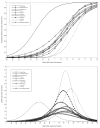Investigating dimensionality and measurement bias of DSM-5 alcohol use disorder in a representative sample of the largest metropolitan area in South America
- PMID: 26002376
- PMCID: PMC4840018
- DOI: 10.1016/j.drugalcdep.2015.04.024
Investigating dimensionality and measurement bias of DSM-5 alcohol use disorder in a representative sample of the largest metropolitan area in South America
Abstract
Background: Given the recent launch of a new diagnostic classification (DSM-5) for alcohol use disorders (AUD), we aimed to investigate its dimensionality and possible measurement bias in a non-U.S.
Methods: The current analyses were restricted to 948 subjects who endorsed drinking at least one drink per week in the past year from a sample of 5037 individuals. Data came from São Paulo Megacity Project (which is part of World Mental Health Surveys) collected between 2005 and 2007. First, exploratory factor analysis (EFA) was carried out to test for the best dimensional structure for DSM-5-AUD criteria. Then, item response theory (IRT) was used to investigate the severity and discrimination properties of each criterion of DSM-5-AUD. Finally, differential criterion functioning (DCF) were investigated by socio-demographics (income, gender, age, employment status, marital status and education). All analyses were performed in Mplus software taking into account complex survey design features.
Results: The best EFA model was a one-dimensional model. IRT results showed that the criteria "Time Spent" and "Given Up" have the highest discrimination and severity properties, while the criterion "Larger/Longer" had the lowest value of severity, but an average value of discrimination. Only female gender had DCF both at criterion- and factor-level, rendering measurement bias.
Conclusion: This study reinforces the existence of a DSM-5-AUD continuum in the largest metropolitan area of South America, including subgroups that had previously higher rates of alcohol use (lower educational/income levels). Lower DSM-5-AUD scores were found in women.
Keywords: DSM-5; Differential item functioning; Exploratory factor analysis; Item response theory; Latin America; Megacities.
Copyright © 2015 Elsevier Ireland Ltd. All rights reserved.
Conflict of interest statement
Dr. Castaldelli-Maia receives Pfizer Independent Grant for Learning and Change (IGLC) managed by Global Bridges (Healthcare Alliance for Tobacco Dependence Treatment) hosted at Mayo Clinic, to support free smoking cessation treatment training in addiction/mental health care units in Brazil (grant IGLC 13513957), which had no relationship with the present study. Dr. Martins is currently a consultant for Purdue Pharma to conduct secondary data analyses of U.S. data unrelated to this project. Dr. A. G. Andrade and Dr. Silveira are respectively Executive President and Coordinator of Center for Information on Health and Alcohol (CISA), which had no funding relationship with this project. All other authors have no conflicts of interest.
Figures


Similar articles
-
DSM-5 latent classes of alcohol users in a population-based sample: results from the São Paulo Megacity Mental Health Survey, Brazil.Drug Alcohol Depend. 2014 Mar 1;136:92-9. doi: 10.1016/j.drugalcdep.2013.12.012. Epub 2014 Jan 3. Drug Alcohol Depend. 2014. PMID: 24440273 Free PMC article.
-
Investigating the dimensional diagnosis of ICD-11 nicotine dependence.Psychol Addict Behav. 2018 Jun;32(4):415-425. doi: 10.1037/adb0000369. Psychol Addict Behav. 2018. PMID: 29927280
-
The role of craving in AUDs: dimensionality and Differential Functioning in the DSM-5.Drug Alcohol Depend. 2012 Sep 1;125(1-2):75-80. doi: 10.1016/j.drugalcdep.2012.03.019. Epub 2012 Apr 17. Drug Alcohol Depend. 2012. PMID: 22516145
-
Dimensionality and stages of severity of DSM-5 criteria in an international sample of alcohol-consuming individuals.Psychol Med. 2014 Nov;44(15):3303-14. doi: 10.1017/S0033291714000889. Epub 2014 Apr 25. Psychol Med. 2014. PMID: 25065388
-
Socio-economic status and problem alcohol use: the positive relationship between income and the DSM-IV alcohol abuse diagnosis.Addiction. 2008 Jul;103(7):1120-30. doi: 10.1111/j.1360-0443.2008.02218.x. Epub 2008 May 20. Addiction. 2008. PMID: 18494841 Free PMC article. Review.
Cited by
-
Commonalities and Differences Across Substance Use Disorders: Phenomenological and Epidemiological Aspects.Alcohol Clin Exp Res. 2015 Oct;39(10):1878-900. doi: 10.1111/acer.12838. Epub 2015 Sep 1. Alcohol Clin Exp Res. 2015. PMID: 26332166 Free PMC article. Review.
-
Reliability of Differential Item Functioning in Alcohol Use Disorder: Bayesian Meta-Analysis of Criteria Discrimination Estimates.Assessment. 2022 Jul;29(5):925-939. doi: 10.1177/1073191120986613. Epub 2021 Feb 20. Assessment. 2022. PMID: 33615848 Free PMC article.
-
Exploring the Role of Alcohol Metabolizing Genotypes in a 12-Week Clinical Trial of Naltrexone for Alcohol Use Disorder.Biomolecules. 2021 Oct 10;11(10):1495. doi: 10.3390/biom11101495. Biomolecules. 2021. PMID: 34680127 Free PMC article. Clinical Trial.
-
The dimensionality of DSM5 alcohol use disorder in Puerto Rico.Addict Behav. 2016 Nov;62:20-4. doi: 10.1016/j.addbeh.2016.06.011. Epub 2016 Jun 7. Addict Behav. 2016. PMID: 27305100 Free PMC article.
-
DSM-5 Alcohol Use Disorder Severity in Puerto Rico: Prevalence, Criteria Profile, and Correlates.Alcohol Clin Exp Res. 2018 Feb;42(2):378-386. doi: 10.1111/acer.13572. Epub 2018 Jan 2. Alcohol Clin Exp Res. 2018. PMID: 29293264 Free PMC article.
References
-
- American Psychiatric Association. Diagnostic and Statistical Manual of Mental Disorders. 5. American Psychiatric Association; Arlington, VA: 2013.
-
- Casey M, Adamson G, Shevlin M, McKinney A. The role of craving in AUDs: dimensionality and differential functioning in the DSM-5. Drug Alcohol Depend. 2012;125:75–80. - PubMed
Publication types
MeSH terms
Grants and funding
- R01 DA016558/DA/NIDA NIH HHS/United States
- R03 TW006481/TW/FIC NIH HHS/United States
- R01DA016558/DA/NIDA NIH HHS/United States
- R01 MH069864/MH/NIMH NIH HHS/United States
- R01MH070884/MH/NIMH NIH HHS/United States
- R01-MH069864/MH/NIMH NIH HHS/United States
- K05 DA015799/DA/NIDA NIH HHS/United States
- R03-TW006481/TW/FIC NIH HHS/United States
- R13-MH066849/MH/NIMH NIH HHS/United States
- R01 MH070884/MH/NIMH NIH HHS/United States
- R01 HD060072/HD/NICHD NIH HHS/United States
- R13 MH066849/MH/NIMH NIH HHS/United States
LinkOut - more resources
Full Text Sources
Other Literature Sources
Medical
Miscellaneous

